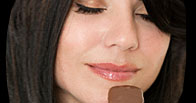Most Common Types of Acne
The most common types of acne occur in the form of whiteheads, blackheads, papules, and pustules. Other forms of acne exist, but either being too rare or too severe for normal treatments, we won't treat them in this article. Some forms of acne, such as cystic acne, don't respond well to normal acne treatments. Such severe forms require the immediate attention of a dermatologist to avoid permanent scarring.
In discussing the following acne formations, the basic formation of each remains the same. Dead skin cells combined with excess sebum cause a blockage creating acne of varying degrees of severity and visibility.
Whiteheads
Whiteheads refer to a formation in the pore which remains closed and beneath the surface of the skin. One should never pop a whitehead, due to the probability of causing additional inflammation and possibly a new and more severe pimple. Whiteheads appear on the surface of the skin as small raised bumps. Whiteheads often precede the formation of papules and pustules, although they may persist as whiteheads for some time.
Blackheads
Blackheads, so named for the black material within the pore, differ from white heads mainly because they are not sealed off beneath the skin. Blackheads, contrary to popular belief, do not contain dirt, rather the melanin in the skin turns black. Blackheads share many of the characteristics of white heads. One thing to note, blackheads tend to be a stable structure and can persist for months before clearing up even with treatment. Read more about blackheads.
Papules
Of the inflammatory formations, papules are the less serious variety. Appearing as small raised bumps with a red irritated appearance, papules indicate a pore which has become inflamed. Once again, papules should be left alone to heal. Avoid touching them. Papules often precede the formation of pustules.
Pustules
The large red inflamed zit showing white on the surface is the pustule. Among common acne, pustules are the worst. Pustules sometimes benefit from proper popping since it evacuates the material within the pustule allowing access by blood and white blood cells to combat the infection. In fact, the white color of the head results from a build up of white blood cells attempting that very thing. Pustules also have the greatest potential to scar. Scratching or picking at pustules often spreads the infection to other pores while increasing the chance of scarring.
The Best Acne Treatments
The best acne treatments include a cleanser, a moisturizer, and supplements to deal with the internal causes of acne. These treatments only work if used correctly, so following the directions is very importation. Although white heads and blackheads may not seem like serious problems, blackheads are unsightly and once formed remain longer than other skin blemishes and white heads indicate a nascent problem that may not be serious, but has the potential of becoming a disfiguring problem. RevitaClear could be the best acne treatment to cleanse and prevent acne breakouts. Called the best cleansing system on the market, RevitaClear believes that the best acne treatment is prevention. Read our RevitaClear review.




